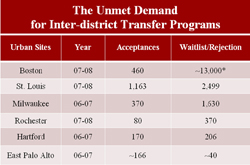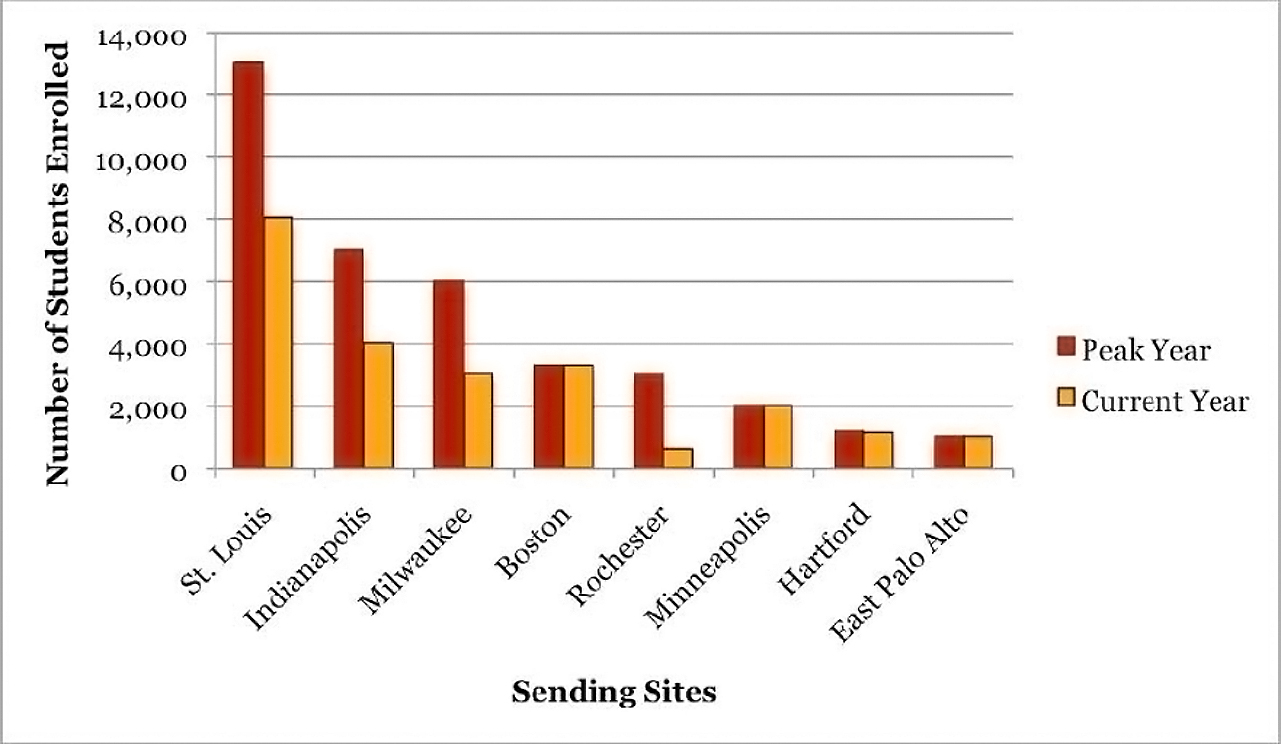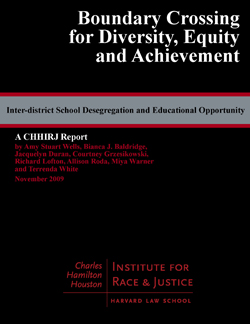Through Integration
By providing poor and minority students access to suburban schools, the nation's remaining "inter-districts" have achieved better outcomes
The first comprehensive study of the nation’s eight remaining inter-district school desegregation programs—which were expressly created to enable disadvantaged, black and Latino students cross school district boundary lines and attend affluent, predominantly white suburban public schools—has found that these programs help close black-white and Latino-white achievement gaps, improve racial attitudes and lead to long-term mobility and further education for the students of color who participate.
“Despite the fact that these programs are out of sync with the current political framing of problems and solutions in the field of education, the research suggests they are far more successful than recent choice and accountability policies at closing the achievement gaps and offering meaningful school choices,” concludes the study, “Boundary Crossing for Diversity, Equity and Achievement: Inter-district School Desegregation and Educational Opportunity,” which was led by TC’s Professor of Sociology and Education Amy Stuart Wells; Wells is also Director of the College’s Center for Understanding Race and Education (CURE).
The study was recently presented at a November conference in Washington , D.C. , Reaffirming the Role of School Integration in K–12 Public Education Policy: A Conversation Among Policymakers, Advocates and Educators, convened by the Charles Hamilton Houston Institute for Race and Justice (CHHIRJ) at Harvard Law School (www.charleshamiltonhouston.org) with the goal of restoring a desegregation focus to U.S.
Among the most striking findings of the study—the sources of which include studies by other researchers, newspaper articles and court documents—is that suburban residents, educators, school officials and students grow to appreciate these programs more the longer they continue. In fact, many former opponents are now defending the programs against threats of curtailment, even when continuation would entail reduced funding.
“The separateness and inequality that characterizes U. S. education along racial/ethnic and social class lines is increasingly circumscribed by school district boundaries,” the authors write, noting the finding of other researchers that “a full 84 percent” of racial/ethnic segregation in U.S.
Yet educational policies addressing segregation and inequality have generally been limited to within-district solutions, beginning with the U.S. Supreme Court’s 1974 ruling in Milliken v. Bradley that federal judges could not order desegregation remedies that send students across urban-suburban district boundaries without substantial, hard-to-document evidence that the suburban districts created the racial segregation. The central policy focus in education has since shifted to the use of standards, tests and accountability systems to improve student achievement, along with school choice policies that allow alternative, private providers to compete for students and their public school funds.
The authors assert these strategies have not delivered, and inequality has grown in many states. “Reams of social science evidence suggest that unless we address the separateness and inequality in which students are being educated, we will never significantly narrow achievement gaps across race and social class lines,” they write.
The inter-district programs (which are voluntary for students) are also school choice plans, in that they all allow students to choose to transfer from one district to the other. Yet, they differ markedly from more recently created school choice plans because of their history and mission to provide viable choices to the most disadvantaged students.
Of the inter-district programs studied, three (Hartford, Minneapolis and Tinsley) were formalized via state court rulings grounded in state constitutional guarantees of equal educational opportunities; three (Indianapolis, Milwaukee and St. Louis) were codified in federal court orders and two (Boston’s METCO and Rochester) were supported by state legislation and local policies to create more racially diverse public schools.
Among the study’s findings about what the inter-districts have achieved:
•In Hartford
•More than half of Project Choice students are performing at or above proficiency on state standardized tests in both math and reading. In fact, the Project Choice students’ test scores and proficiency rates are higher than their Hartford Public School
•In a study of the St. Louis program, African American students who transfer to suburban schools and remain there over time far outperform their peers in the city’s magnet or neighborhood schools by the time they reach 10th grade.
•A 1995 report on the St. Louis
•An analysis of the college-prep curriculum in urban (non-magnet) versus suburban schools in St. Louis found that the city schools teach fewer foreign languages, have fewer counselors, and offer fewer advanced courses in math and science. They also lack music programs and up-to-date science labs and libraries.
•In St. Louis
The benefits of the inter-district programs program hold up over the long term. Black students who attended suburban schools through Project Concern were more likely to graduate from high school and complete more years of college than members of the control group who remained in the Hartford Public Schools.
Policy Recommendations
The Wells study of Inter-Districts recommends that any new federal or state policies to foster inter-district public school choice must have the following characteristics to support a non-competitive, but equity-minded framework for school choice policies:
1. Target and Support Meaningful School Choices for the Most Disadvantaged Students;
2. Foster and Support Significant Participation of Suburban Districts; and
3. Further the Goal of Equity in Urban and Suburban Public Education.
The inter-district study co-authors are Bianca Baldridge, Jacquelyn Duran, Courtney Grzesikowski, Richard Lofton, Allison Roda, Miya Warner and Terrendra White. To view the full study, visit www.tc.edu/news/7232.
Published Monday, Jan. 11, 2010



